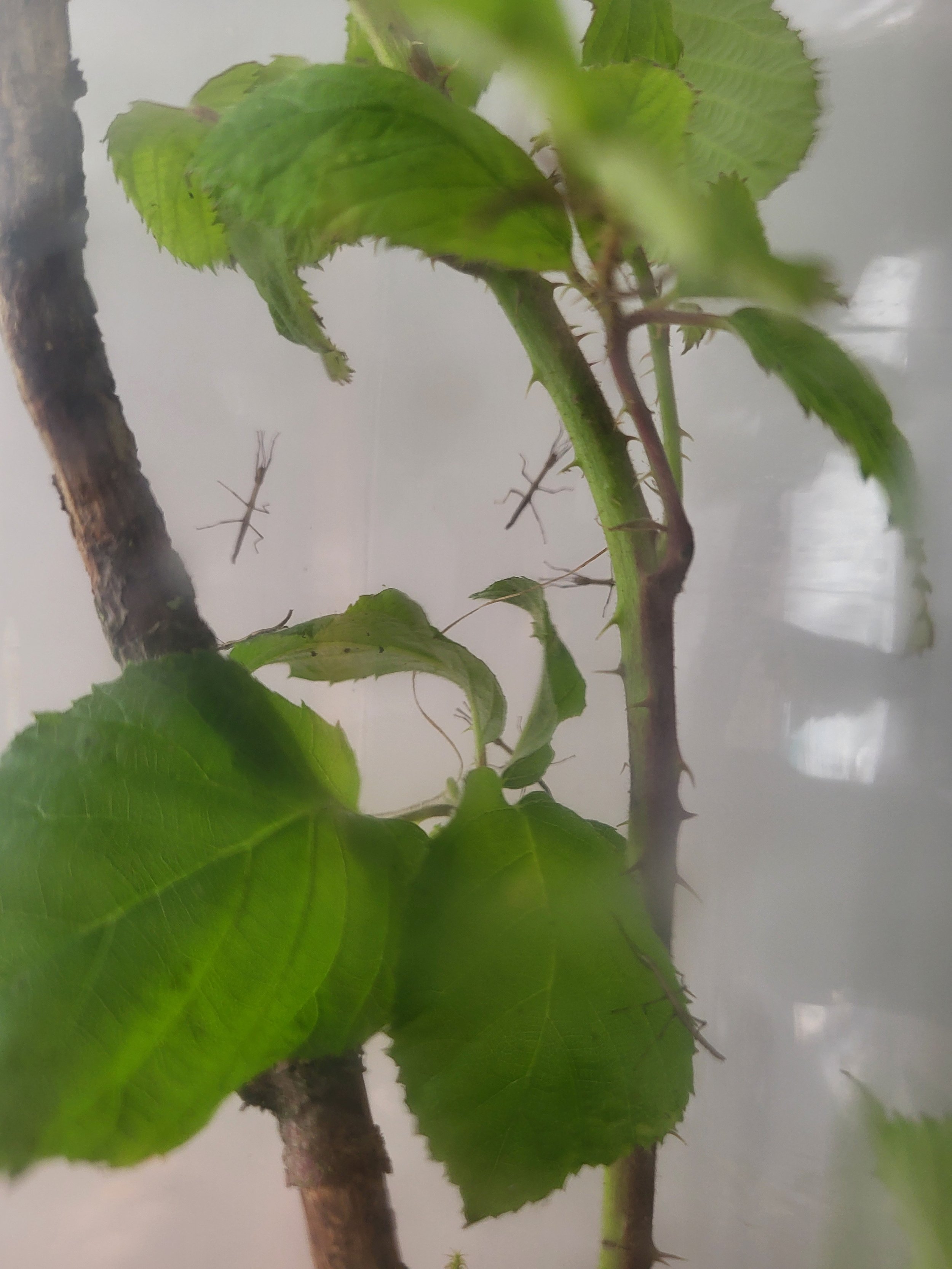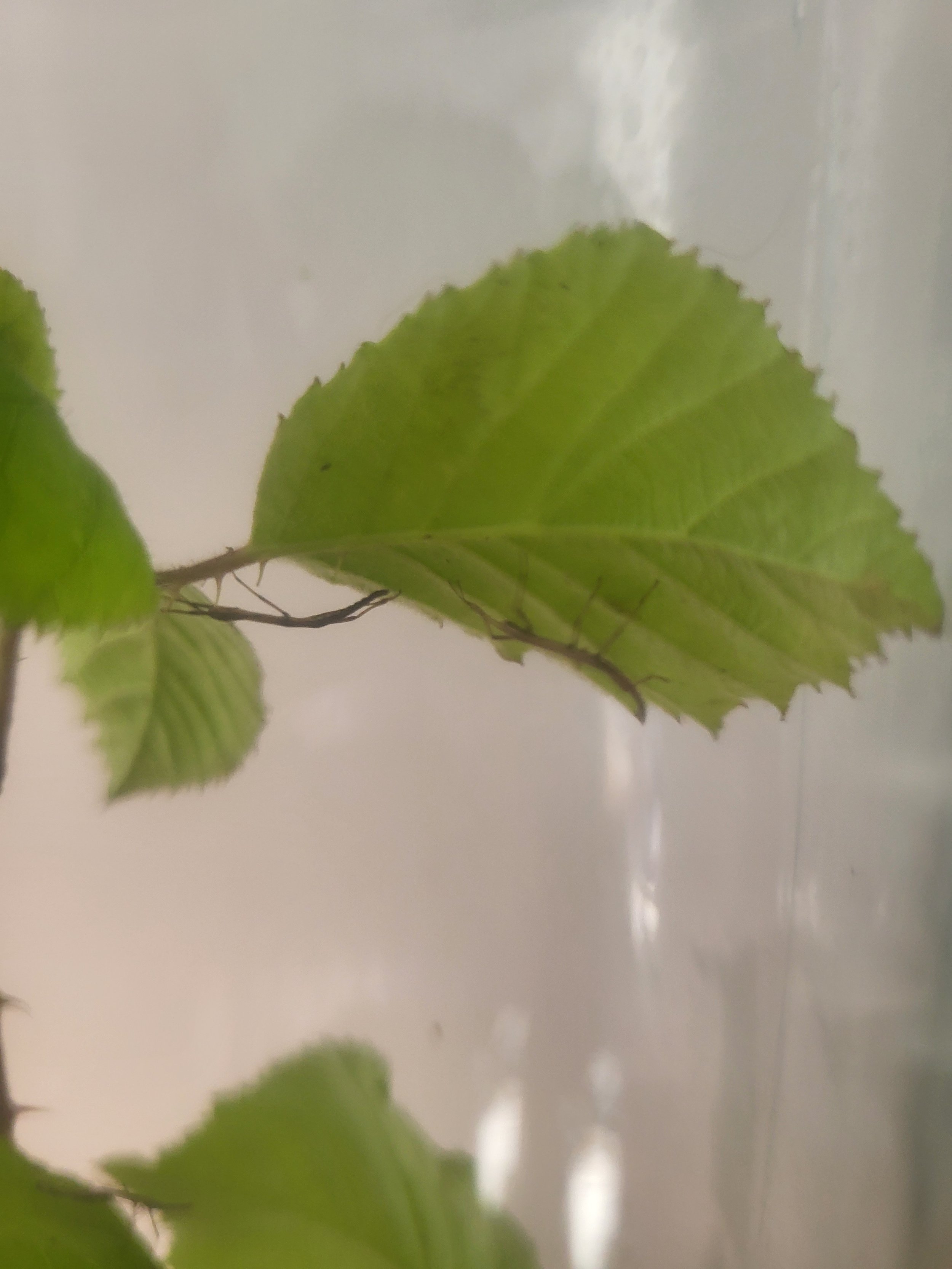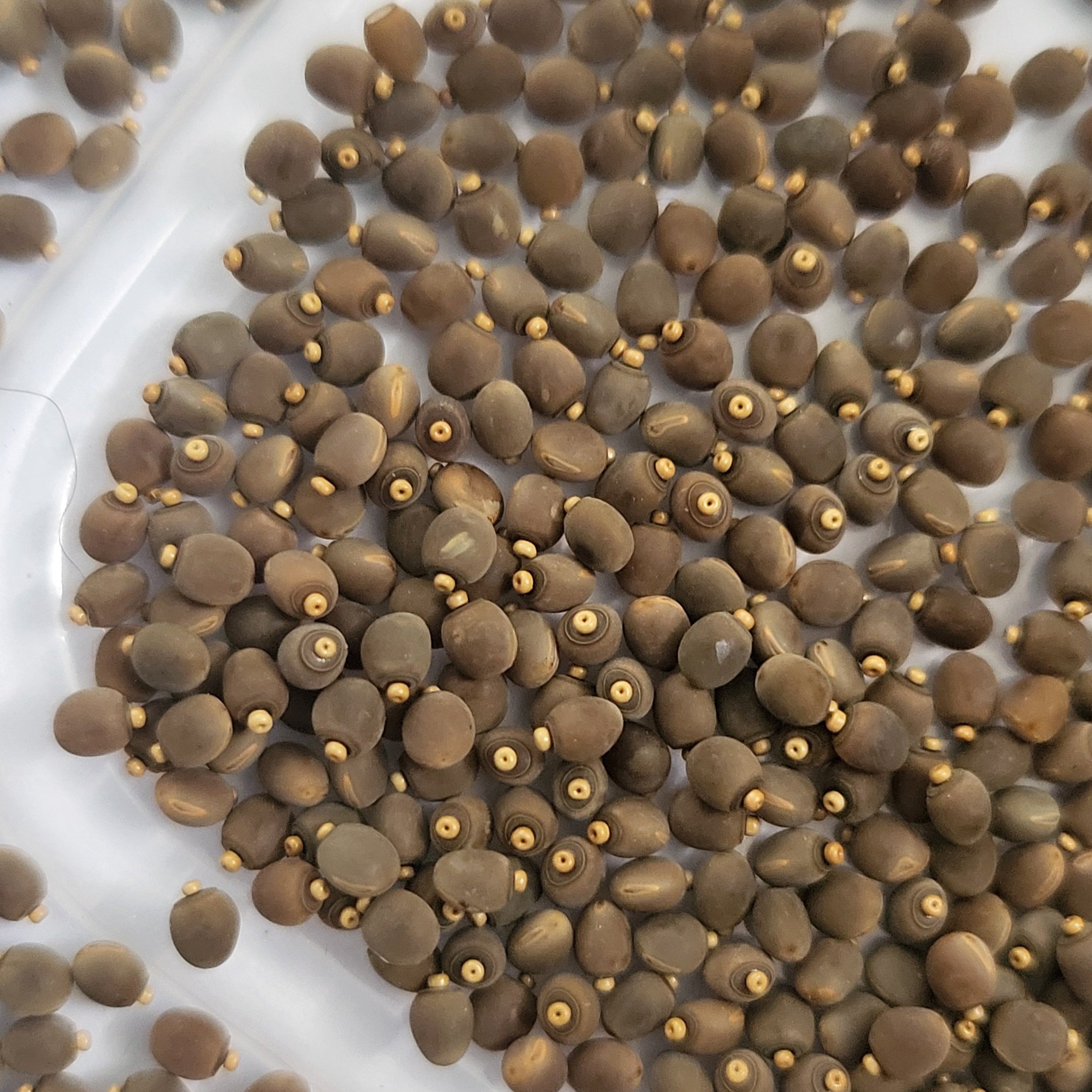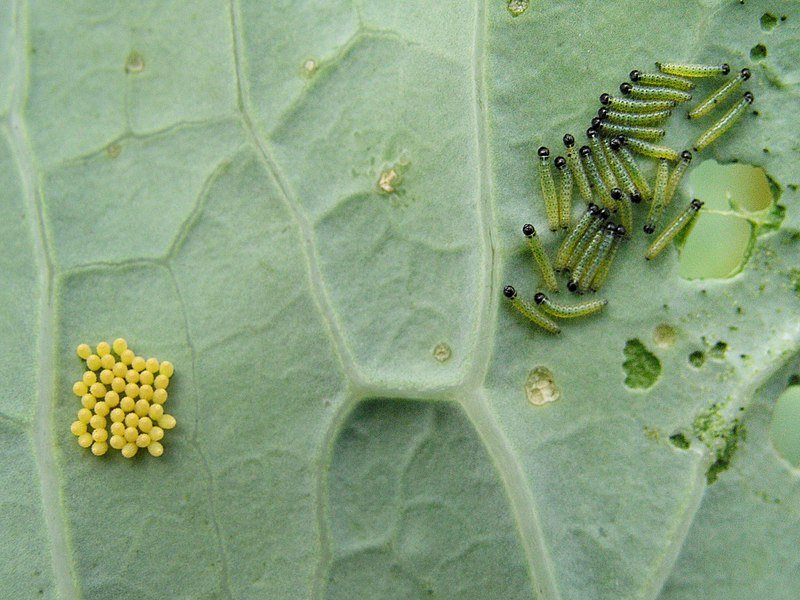 Image 1 of 2
Image 1 of 2

 Image 2 of 2
Image 2 of 2



3 Indian Stick Insect Nymphs
Indian Stick Insect Nymphs
Quantity: 3
Origin: Captive bred, UK
Life Span: ~12 Months
Adult Size: 5-10cm
Current size (~1cm)
Hatched: Week Commencing: 14/07/2025
Temperature Requirements: They will do fine at room temperature however a heat mat at 20-24 degrees C can be used.
Humidity: 60-80%
Diet: Bramble, will also accept Ivy, Privet, Hawthorn, Oak and Hazel
Why You’ll Love Them:
These gentle herbivores are low-maintenance and fascinating to watch, mimicking twigs with uncanny precision. A perfect addition to a living insect collection or as a unique project for schools. They do lay a lot of eggs once mature and do not require a mate to do so. To easily spot eggs use kitchen towel on the bottom of your cage so you can easily remove eggs. If you do not watch to hatch all/any of your eggs you can simply destroy these by placing them in the freezer before discarding them - do not discard live eggs.
Care Notes:
When your stick insects are very young (and very small) they may escape through air holes, so it can be beneficial to also provide an layer of netting under the lid of your container. Make sure there are places provided for your nymphs to hang upside down and change their skins - this is how they grow. They will hang from sticks or from netting to do this.
Your Indian Stick Insect nymphs will begin to grow, reaching around 4 inches long over the next few months, and they should live for around 12 months with the correct care. Adult Indian Stick Insects are long and thin and to be able to moult need to hang upside down so it is important to ensure that their cage provides enough height for this - ideally the care needs to be at least 3 times the length of the insect.
HANDLING:
Be gentle when handling, being too rough may cause your insects harm, they could for instance loose a leg! A gentle nudge will get them to walk on to your hand, do not hold them by their legs or grab them by their bodies.
do not handle them when they are in the process of changing skins, or just after they have changed skins as the process can leave them in a vulnerable state and if not completed properly and without interruption may cause them to die.
TEMPERATURE:
Keep the cages away from direct sun light. The Indian Stick Insects are happy at normal room temperatures (12-24 degrees Celsius). Just keeping them at normal room temperature is fine. Do not allow them to get too cold.
MOISTURE:
It is a good idea to mist their cage and food plant lightly with water 1-2 times a week. Sometimes you will see them drinking tiny water droplets if they are thirsty. Generally tap water is fine, but let it stand for a while before spraying so that it is not too cold and any chlorine present has evaporated. Note: Too much moisture can attract mould, this is less likely to happen if the cage is well ventilated.
FEEDING:
Make sure that your stick insects always have plenty of fresh food. Avoid giving them cuttings from plants close to roads or that have been sprayed with insecticide.
Indian stick insects will eat the leaves from Bramble and Privet, both of which can be found year round - they may also take to Oak and Hawthorn may also be accepted through the Spring and summer months.
BREEDING:
Most Indian Stick Insects are female. The females will lay eggs which will hatch, they do not require a male to pair with in order to produce eggs.
They will lay a lot of eggs, these will drop to the bottom of the cage, so keep and eye out for these once your stick insects are grown - they will be among the poo at eh bottom of the cage.
As they lay a lot of eggs it can be easy to become over run. If you do not want to hatch any more eggs (or you have too many) it is important that these are disposed of correctly - of course you can give them away to other people who want to raise them, but the other alternative is to place any unwanted eggs in the freezer for a little while before discarding to ensure they are no longer viable.
PRECAUTIONS:
Stick insect are not native to Britain. Therefore it is illegal to release them in to the wild - this includes hatched insects and eggs.
Mould can be toxic to stick insects. Substantial mould growth in neglected containers may even become toxic to humans. To prevent mould growth do not over spray with water and if mould does begin to grow it is important that the cage is thoroughly cleaned.
As with all pets it is recommended that you watch your hands before and after handling.
Your nymphs will be sent 24 hour tracked. Live insects are only posted Monday-Wednesday to avoid the possibility of being stuck in the sorting office over the weekend. If there is going to be a delay in shipping due to things like extreme weather we will let you know - the welfare of our specimens is our top priority.
If you order after 10am on Wednesday your insects will be shipped the following Monday.
Indian Stick Insect Nymphs
Quantity: 3
Origin: Captive bred, UK
Life Span: ~12 Months
Adult Size: 5-10cm
Current size (~1cm)
Hatched: Week Commencing: 14/07/2025
Temperature Requirements: They will do fine at room temperature however a heat mat at 20-24 degrees C can be used.
Humidity: 60-80%
Diet: Bramble, will also accept Ivy, Privet, Hawthorn, Oak and Hazel
Why You’ll Love Them:
These gentle herbivores are low-maintenance and fascinating to watch, mimicking twigs with uncanny precision. A perfect addition to a living insect collection or as a unique project for schools. They do lay a lot of eggs once mature and do not require a mate to do so. To easily spot eggs use kitchen towel on the bottom of your cage so you can easily remove eggs. If you do not watch to hatch all/any of your eggs you can simply destroy these by placing them in the freezer before discarding them - do not discard live eggs.
Care Notes:
When your stick insects are very young (and very small) they may escape through air holes, so it can be beneficial to also provide an layer of netting under the lid of your container. Make sure there are places provided for your nymphs to hang upside down and change their skins - this is how they grow. They will hang from sticks or from netting to do this.
Your Indian Stick Insect nymphs will begin to grow, reaching around 4 inches long over the next few months, and they should live for around 12 months with the correct care. Adult Indian Stick Insects are long and thin and to be able to moult need to hang upside down so it is important to ensure that their cage provides enough height for this - ideally the care needs to be at least 3 times the length of the insect.
HANDLING:
Be gentle when handling, being too rough may cause your insects harm, they could for instance loose a leg! A gentle nudge will get them to walk on to your hand, do not hold them by their legs or grab them by their bodies.
do not handle them when they are in the process of changing skins, or just after they have changed skins as the process can leave them in a vulnerable state and if not completed properly and without interruption may cause them to die.
TEMPERATURE:
Keep the cages away from direct sun light. The Indian Stick Insects are happy at normal room temperatures (12-24 degrees Celsius). Just keeping them at normal room temperature is fine. Do not allow them to get too cold.
MOISTURE:
It is a good idea to mist their cage and food plant lightly with water 1-2 times a week. Sometimes you will see them drinking tiny water droplets if they are thirsty. Generally tap water is fine, but let it stand for a while before spraying so that it is not too cold and any chlorine present has evaporated. Note: Too much moisture can attract mould, this is less likely to happen if the cage is well ventilated.
FEEDING:
Make sure that your stick insects always have plenty of fresh food. Avoid giving them cuttings from plants close to roads or that have been sprayed with insecticide.
Indian stick insects will eat the leaves from Bramble and Privet, both of which can be found year round - they may also take to Oak and Hawthorn may also be accepted through the Spring and summer months.
BREEDING:
Most Indian Stick Insects are female. The females will lay eggs which will hatch, they do not require a male to pair with in order to produce eggs.
They will lay a lot of eggs, these will drop to the bottom of the cage, so keep and eye out for these once your stick insects are grown - they will be among the poo at eh bottom of the cage.
As they lay a lot of eggs it can be easy to become over run. If you do not want to hatch any more eggs (or you have too many) it is important that these are disposed of correctly - of course you can give them away to other people who want to raise them, but the other alternative is to place any unwanted eggs in the freezer for a little while before discarding to ensure they are no longer viable.
PRECAUTIONS:
Stick insect are not native to Britain. Therefore it is illegal to release them in to the wild - this includes hatched insects and eggs.
Mould can be toxic to stick insects. Substantial mould growth in neglected containers may even become toxic to humans. To prevent mould growth do not over spray with water and if mould does begin to grow it is important that the cage is thoroughly cleaned.
As with all pets it is recommended that you watch your hands before and after handling.
Your nymphs will be sent 24 hour tracked. Live insects are only posted Monday-Wednesday to avoid the possibility of being stuck in the sorting office over the weekend. If there is going to be a delay in shipping due to things like extreme weather we will let you know - the welfare of our specimens is our top priority.
If you order after 10am on Wednesday your insects will be shipped the following Monday.

